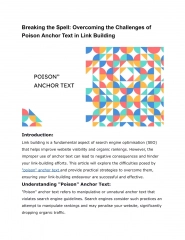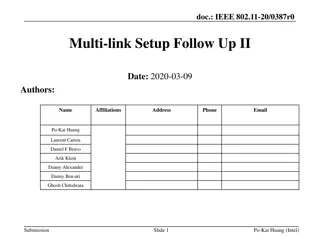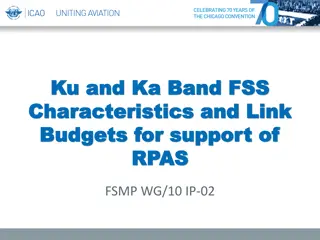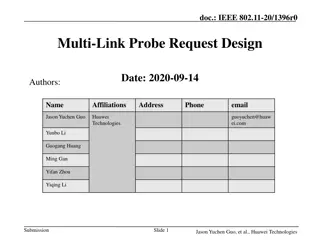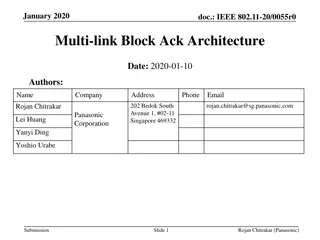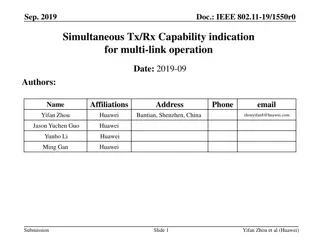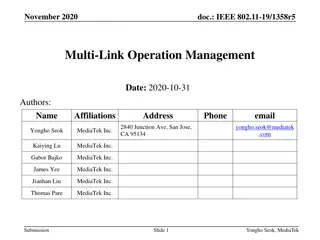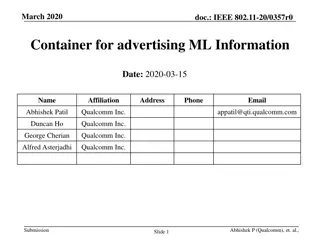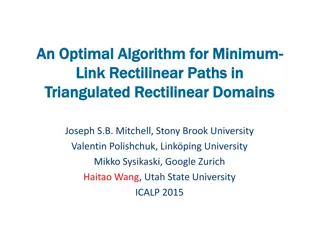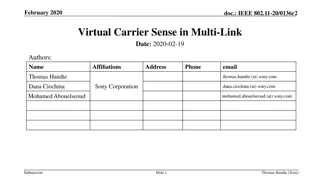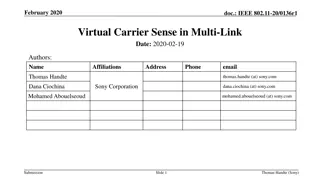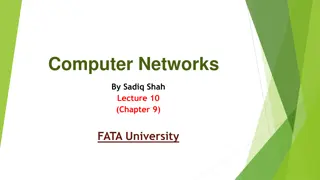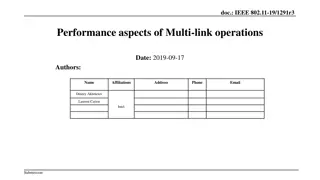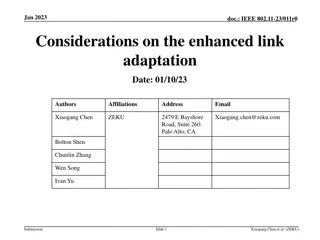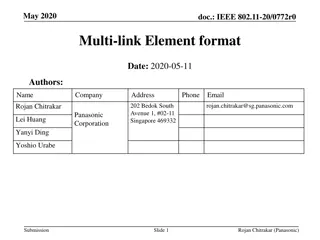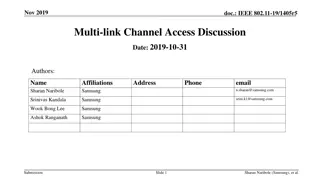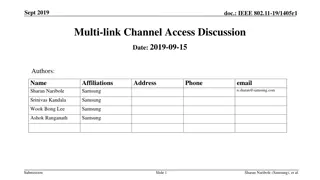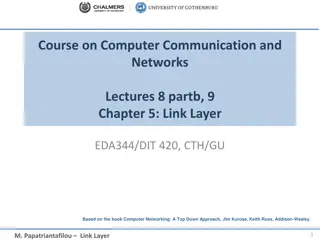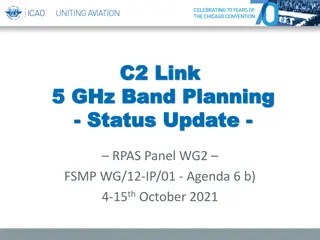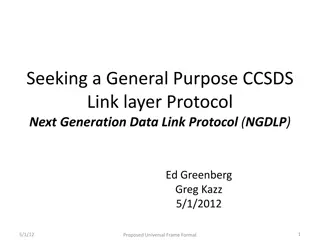Adaptive Tree-based Convergecast Protocol
Adaptive tree-based protocol for managing overlay networks in heterogeneous networks. It proposes improvements to the existing Tree-Based Convergecast Routing (TBCR) protocol by considering additional parameters such as RTT, power consumption, link stability, and link mobility to optimize routing de
32 views • 12 slides
Breaking the Spell_ Overcoming the Challenges of Poison Anchor Text in Link Building
Link building is a fundamental aspect of search engine optimisation (SEO) that helps improve website visibility and organic rankings. However, the improper use of anchor text can lead to negative consequences and hinder your link-building efforts.
1 views • 3 slides
SINGLE DISCONNECTING LINK EARTH BAR
Nexus Metal & Alloys is one of the leading manufacturers, exporters, and suppliers of world-class Copper Single Disconnecting Link Earth Bar, Six Way Earth Bar with Single Disconnecting Link, Copper Single Disconnecting Earth Bar at very cheap rate from Mumbai, Maharashtra, India.
4 views • 4 slides
Improving Multi-Link Power Management Efficiency in IEEE 802.11 Networks
The document discusses challenges with per-link power mode changes in multi-link scenarios in IEEE 802.11 networks, proposing a solution for more efficient power management. It addresses issues such as latency and inefficiencies in signaling for power mode changes, introducing scheduled multi-link p
6 views • 9 slides
Progress on IEEE 802.11 Multi-link Setup
Significant developments have been made in the multi-link setup within the IEEE 802.11 framework. The focus is on allowing only one STA in the MLD framework, differentiation with STA-level associations, and the rationale behind restricting to one STA. Proposals for defining multi-link devices and re
0 views • 12 slides
Understanding the Importance of FSS Link Budgets for RPAS Operations
FSS link budgets play a crucial role in ensuring the required performance of C2 links for RPAS operations. They help confirm achievable link performance, define minimum performance values, establish operational and technical boundary conditions, and assess RLP conformity in satellite networks. By de
2 views • 26 slides
Design Considerations for Multi-Link Probe Requests in IEEE 802.11-20
This document discusses the design considerations for multi-link probe requests in the IEEE 802.11-20 standard. It covers passive and active scanning methods, MLD-based versus link-based approaches, and probing for multiple BSSIDs. The focus is on enhancing efficiency and reducing frame bloating in
0 views • 16 slides
IEEE 802.11-20/0772r2 Multi-Link Elements Overview
IEEE 802.11-20/0772r2 discusses various aspects of multi-link elements in the context of IEEE 802.11 standards. The document covers the need for efficient element ID extension, different multi-link element structures, including authentication algorithms, common controls, and sub-elements organizatio
1 views • 10 slides
IEEE 802.11-20/0055r0 Multi-link Block Ack Architecture Overview
This document from January 2020 presents an overview of the IEEE 802.11-20/0055r0 Multi-link Block Ack architecture proposed by Rojan Chitrakar from Panasonic. It discusses the negotiation of block ack agreements between multiple MLDs, common sequence number assignment, transmit and receive buffers,
1 views • 11 slides
IEEE 802.11-2020 Multi-Link Reference Model Discussion
This contribution discusses the reference model to support multi-link operation in IEEE 802.11be and proposes architecture reference models to support multi-link devices. It covers aspects such as baseline architecture reference models, logical entities in different layers, Multi-Link Device (MLD) f
1 views • 19 slides
IEEE 802.11-23/1980r1 Coordinated AP-assisted Medium Synchronization Recovery
This document from December 2023 discusses medium synchronization recovery leveraging multi-AP coordination for multi-link devices. It covers features such as Multi-link device (MLD), Multi-link operation (MLO), and Ultra High Reliability (UHR) capability defined in P802.11bn for improvements in rat
0 views • 8 slides
IEEE 802.11-19/1575r0 Multi-Link BA Operation Overview
Presentation slides from September 2019 discussing the Multi-Link Operation (MLO) in IEEE 802.11-19/1575r0 standard. The slides cover topics such as the benefits of MLO, synchronized/asynchronized rules, terminology, architecture, and common BA sessions. The proposal aims to define an architecture s
0 views • 25 slides
Samsung EX-LINK Guide for BEN Series LFD Q2 2019
EX-LINK Control is a Samsung industry standard for RS232C control protocols, utilized in the BEN series of Commercial LFD products. The guide covers Samsung EX-LINK code structure, checksum calculation, connector pin-outs, and more. Learn how to format commands, calculate checksums, and adapt pinout
6 views • 6 slides
IEEE 802.11-19/1550r0: Simultaneous Tx/Rx Capability Indication for Multi-Link Operation
This document discusses the simultaneous Tx/Rx capability indication for multi-link operation in IEEE 802.11-19/1550r0. It covers scenarios where link selection depends on link capabilities, actions needed based on Tx/Rx capabilities, and methods to indicate simultaneous operation. The importance of
4 views • 10 slides
Enhancing IEEE 802.11 with Multi-Link Acknowledgment Mechanism
This document explores the concept of multi-link transmission in IEEE 802.11 networks as a means to enhance peak throughput. It delves into the proposal of a multi-link block acknowledgment mechanism for more efficient data transmission. The discussion includes details on existing block acknowledgme
0 views • 16 slides
IEEE 802.11-20/0370r0 Multi-link Power Save Discussion
The document discusses multi-link power saving in the IEEE 802.11be standard. It reviews extreme low power multi-link operation modes, emphasizing the importance of enabling a single link for practical power savings. The proposed extreme low power mode introduces fixed and dynamic anchor links for e
0 views • 11 slides
IEEE 802.11-19/1358r5 Multi-Link Operation Management Overview
This document provides insights into the multi-link operation management proposed for IEEE 802.11-19/1358r5 standard by MediaTek Inc. The concept involves handling multi-link entities, such as APs and STAs, for improved performance in different environments. It discusses the architecture, motivation
0 views • 15 slides
Framework for Advertising Multiple-Link Operations in IEEE 802.11
Proposed framework for advertising Multiple-Link Operations (MLO) capabilities in IEEE 802.11 networks classified into three categories: Common MLD Information, Per-Link Information, and Multiple BSSID features. Introduces a new element, Multiple Link Attribute (MLA) element, with profiles for each
0 views • 27 slides
Optimized Algorithm for Minimum Link Rectilinear Paths in Triangulated Domains
This study presents an optimal algorithm for finding the minimum link rectilinear paths in triangulated domains, focusing on solving the minimum-link path problem efficiently. The research covers various scenarios, such as general polygonal domains and rectilinear cases, proposing new algorithms and
0 views • 24 slides
Backup Link Establishment for Low Latency Communication
Achieving low latency communication is crucial when link quality deteriorates. This presentation by Qi Wang et al. from Apple Inc. introduces the concept of establishing a Backup Link to swiftly switch LL communication to a better link, enhancing data transmission efficiency in scenarios where the p
3 views • 12 slides
IEEE 802.11-20/0136r2: Virtual Carrier Sense in Multi-Link Networks
In this document presented in February 2020, the focus is on the implementation of virtual carrier sense (CS) in the context of multiple links in IEEE 802.11-20/0136r2. The advantages of NAC in asynchronous multi-link scenarios are discussed, emphasizing the mitigation of the hidden node problem and
0 views • 16 slides
Enhancing High School Transition with Link Crew Program
Link Crew is a high school transition program designed to support incoming freshmen by pairing them with junior and senior mentors known as Link Leaders. These mentors help guide and support the freshmen throughout their first year, making the transition to high school smoother and increasing their
2 views • 40 slides
Virtual Carrier Sense in Asynchronous Multi-Link Networks
Exploring the implementation of virtual carrier sense in asynchronous multi-link networks based on IEEE 802.11 standards. The presentation discusses the benefits of using NAV (Network Allocation Vector) in asynchronous multi-link setups to avoid hidden node issues, improve throughput, and latency. I
0 views • 16 slides
Virtual Carrier Sense in Multi-Link Networks
This document discusses the implementation and advantages of virtual carrier sense in multi-link networks under the IEEE 802.11 standard. It explores the operation of multi-link setups, asynchronous communication benefits, and the necessity of multiple contention channels. The concept of NAV (Networ
2 views • 11 slides
Understanding Data Link Layer Communication in Computer Networks
Exploring the data link layer in computer networks, this lecture discusses the node-to-node communication, services provided, such as framing, flow control, error control, and congestion control. Through a series of images, the concept of links and nodes, as well as the responsibilities of the data
0 views • 16 slides
Understanding Data Link Layer in Computer Networking
The Data Link Layer (DLL) is the second layer of the OSI model, responsible for error detection and correction, framing, addressing, synchronization, flow control, and multi-access protocols. It deals with logical link control and media access control, addressing destination hardware, avoiding data
0 views • 49 slides
Fundamentals of Data Link Layer and Ethernet in Computer Networks
Delve into the essential concepts of the Data Link Layer and Ethernet in computer networking, covering services like framing, error detection, correction, reliable delivery, and more. Explore how frames transfer data between nodes, the importance of link protocols, and the role of MAC protocols in l
0 views • 46 slides
Enhancing Efficiency and Latency Reduction in IEEE 802.11be Through Multi-Link Operation
Targeted at improving multi-link and low-latency capabilities in IEEE 802.11be, this document proposes a mode of operation utilizing multiple links to decrease latency effectively. By addressing channel access delay reduction and discussing the benefits of multi-link definitions, the document emphas
0 views • 17 slides
Performance Aspects of Multi-link Operations in IEEE 802.11-19/1291r0
This document explores the performance aspects, benefits, and assumptions of multi-link operations in IEEE 802.11-19/1291r0. It discusses the motivation for multi-link operation in new wireless devices, potential throughput gains, classification of multi-link capabilities, and operation modes. The s
0 views • 30 slides
Performance Aspects of Multi-link Operations in IEEE 802.11-19/1291r3
This document discusses the motivation, assumptions, and classifications related to multi-link operations in IEEE 802.11-19/1291r3 standard. It explores the benefits of multi-link capabilities in new wireless devices, such as improved throughput, reduced latency, and potential for link aggregation.
0 views • 18 slides
Enhancements in Link Adaptation for IEEE 802.11 Standards
Discussions in the Jan. 2023 document focus on enhanced link adaptation considerations for IEEE 802.11 standards, particularly in 11be and 11ax. Various improvements and challenges in link adaptation are highlighted, emphasizing the need for enhanced link adaptation (ELA) to address issues like inte
0 views • 14 slides
Presentation Slides and Video Link
The content includes a series of images featuring presentation slides, each with a width of 900px, along with a YouTube video link. The slides vary in content and are followed by the link to a specific YouTube video. The visuals are in WebP format and can be viewed individually. The video link leads
0 views • 13 slides
Proposal for Common Multi-link Element in IEEE 802.11-20/0772r0
Various multi-link elements have been proposed in IEEE 802.11 standards, leading to potential space limitations. The proposal suggests a common multi-link element with a Type field to distinguish different usages efficiently, potentially streamlining multi-link operations without unnecessary complex
0 views • 9 slides
IEEE 802.11-19/0773r0 Multi-link Operation Framework Summary
The document discusses the multi-link operation framework for IEEE 802.11-19/0773r0, focusing on load balancing and aggregation use cases. It introduces terminology related to multi-link logical entities and provides examples of multi-link AP and non-AP logical entities. The framework considers stee
0 views • 16 slides
IEEE 802.11-17: Enhancing Multi-Link Operation for Higher Throughput
The document discusses IEEE 802.11-17/xxxxr0 focusing on multi-link operation for achieving higher throughput. It covers motions adopted in the SFD related to asynchronous multi-link channel access, mechanisms for multi-link operation, and shared sequence number space. Additionally, it explores the
0 views • 14 slides
IEEE 802.11-19/1405r5 Multi-Link Channel Access Discussion
The document discusses multi-link channel access in IEEE 802.11-19/1405r5, focusing on aspects like transmission of frames over multiple links, minimizing negotiation overhead for fast link switching, and per-link backoff procedures. It covers asynchronous and synchronous operations, STR constraints
0 views • 17 slides
IEEE 802.11-19/1405r1 Multi-link Channel Access Discussion
Introduction to multi-link channel access in IEEE 802.11-19/1405r1 focusing on asynchronous and synchronous operations, per-link backoff procedures, simultaneous transmit and receive operations, and the challenges posed by STR constraints at the access points. The document discusses the capabilities
0 views • 18 slides
Understanding the Link Layer in Computer Communication and Networks
The link layer, an essential component in computer networks, is implemented at every host through adapters like NICs or Ethernet/802.11 cards. It handles tasks such as frame encapsulation, error checking, and flow control to ensure reliable data transmission between nodes. Link layer services includ
0 views • 64 slides
C2.Link 5GHz Band Planning Overview
The C2.Link 5GHz Band Planning involves allocation to AM(R)S, AMS(R)S, and ARNS on a co-primary basis, with ICAO systems and MLS given priority. RTCA MOPS for a terrestrial C2 Link system and EUROCAE MOPS for a geostationary satellite-based system were released. The use of TDD waveforms in RTCA DO-3
0 views • 13 slides
Seeking a General-Purpose CCSDS Link Layer Protocol: Next-Generation Data Link Protocol (NGDLP)
This document discusses the proposed Universal Frame Format for a next-generation data link protocol, focusing on major questions about transfer frames, Protocol Link Transmission Unit (PLTU), and Universal Transfer Frame Structure. It explores topics such as frame formats, telemetry transfer frames
0 views • 24 slides

